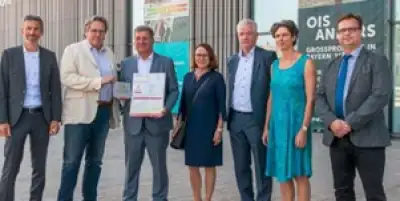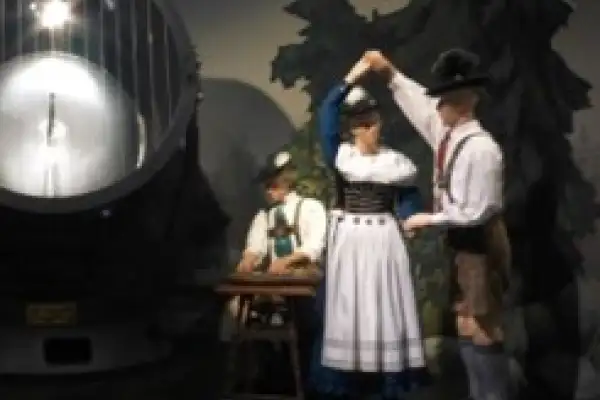The House of Bavarian History in the southern German city of Regensburg is now the largest certified museum in the world that is built to the Passive House standard (ID 6341). This impressive building was recently awarded its Passive House certification. The energy for heating and cooling is generated from the wastewater of the city by means of a modern energy center that is compatible with the historic city center.

History Meets Energy Efficiency
The façade of the “Haus der Bayerischen Geschichte” (“House of Bavarian History”) advertises the current exhibition with the Bavarian dialect title "Ois anders" ("Everything's different"). In a way, this also applies to the building itself. "We are Passive House!” said museum director Richard Loibl proudly when he received the Passive House certificate from Bavaria's Minister of Construction Christian Bernreiter. With 7,700 square meters (≈83,000 square feet) of treated floor area, the House of Bavarian History is now also the largest certified Passive House museum in the world. The Passive House Institute, which ultimately reviewed the certification, was present for the handover of the certificate in Regensburg.

Compensating Fluctuations
The House of Bavarian History in Regensburg went into operation in 2019 after three years of construction. Its owner is the Federal State of Bavaria. The German planning company Wörner Traxler Richter won the architectural competition; they also planned the world's first certified Passive House hospital in Frankfurt, Germany. It was clear from the outset that the new museum was to be built to the highly energy-efficient Passive House standard. The Passive House designers from Herz und Lang undertook the energy consultancy and calculations. "The challenge was to ensure consistent climatic conditions in the interior spaces despite fluctuating visitor numbers and varying temperatures. This is particularly important for preserving the exhibits in the long term," explains Esther Gollwitzer from the Passive House Institute in Darmstadt, who reviewed the certification.
Lots of Visitors Means Lots of Heat and Humidity
Large numbers of visitors, who flock to the museum for its exhibits (right), lead to high heat and humidity loads. Besides the requirement for completely doing away with fossil fuels, the goal was to guarantee indoor temperatures of between 18°C and 20°C (64°F and 68°F) in winter and between 23°C and 25°C (73°F and 77°F) in summer, with a constant air humidity of 45 to 55 per cent. To avoid problems with condensation, the requirements for building assemblies and component connections were therefore also high. In addition, solar radiation and the additional internal heat loads caused by media technology and the lighting for exhibits had to be taken into account.



Heating and Cooling From Wastewater
The museum uses the heat potential of the sewer system to supply heating and cooling. In 2018, the city of Regensburg put into operation an energy center in which heat pumps supply the energy contained in the city's wastewater of 150,000 inhabitants for heating and cooling the museum. The main sewer provides a constant temperature level almost all year round. Heating and cooling is mainly provided using the floor areas of the museum. Peak loads are dealt with by the ventilation systems with heat and cold recovery. Humidification and dehumidification take place in some areas. Adiabatic cooling (evaporative cooling) is also available. In the context of operations optimization, the running time of the building services technology, including that of the ventilation system, was reduced, and further energy conservation measures were implemented.

Optimized Operation
Since August 2022, the museum has recorded total savings during operation of around 65,000 kWh of electrical energy per month as a result of the optimization, as published by the museum in its 2023 annual assessment. "These high energy savings with simultaneous stability of the indoor climate in the exhibition rooms are only possible thanks to the high-quality and airtight building envelope, i.e. the Passive House standard. There is hardly any better argument for implementing a high level of energy efficiency in museums," explains Joachim Blaas from Herz und Lang.
Compatible with Heritage Preservation
Regensburg's Mayor Gertrud Maltz-Schwarzfischer pointed out that this modern museum building is already the second building for which the city has made it possible to generate energy from wastewater after its “House of Music” (“Haus der Musik”). Both buildings demonstrate how effectively renewable energy can be used in the historic part of the city center: the use of heat from wastewater has been integrated into the existing sewer system and is compatible with heritage protection regulations. Bavaria's Construction Minister Christian Bernreiter explained that the highly efficient Passive House standard has proved successful not only from a construction perspective. Energy-efficient construction was an essential building block for achieving climate protection targets, Bernreiter said. The aim was to minimize energy consumption and, therefore, also reduce energy costs during operation. Museum director Richard Loibl indicated that the museum was planning additional adjustments. Energy consumption will be reduced even further and a photovoltaic system will also be installed, while part of the façade will be implemented as a "green wall".

"Passive" Exhibition Areas
In addition to the House of the Bavarian History with 7,700 m² of treated floor area (TFA), there are other certified Passive House museum/exhibition buildings which are accessible to the public. Some examples from around the world: In China, there are the Technical and Experience Center in Qingdao (7,535 m² [81,106 ft²] TFA) and the Experience Hall in Taizhou (2,462 m² [26,500 ft²] TFA), the Archive and Record Centre (HARC) in Hereford, UK (2,410 m² [25,941 ft²] TFA), a car dealership in Red Deer, Canada (1,542 m² [16,598 ft²] TFA) and the entrance building of the Museum Village Niedersulz in Austria (1,193 m² [12,841 ft²] TFA). The Ravensburg Art Museum (1,287 m² [13,853 ft²] TFA) was the first museum to receive the Passive House certificate in 2013 and was also awarded the German Architecture Prize in the same year. It also received the Passive House Award 2014.